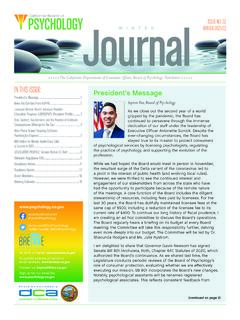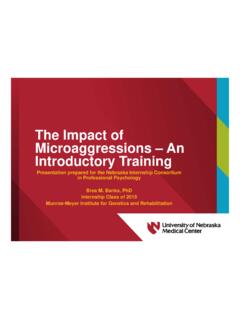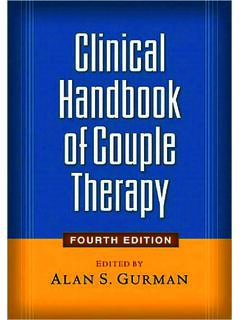Transcription of CHAPTER Methods of Treatment - CSUN
1 CHAPTERM ethods of TreatmentCHAPTER OUTLINETYPES OF HELPING PROFESSIONALS 104 PSYCHOTHERAPY 104 125 Psychodynamic TherapyBehavior TherapyHumanistic TherapyCognitive TherapyCognitive-Behavioral TherapyEclectic TherapyGroup, Family, and Couple TherapyEvaluating Methods of PsychotherapyMulticultural Issues in PsychotherapyEthnic Group Differences in Use of MentalHealth ServicesRacial Stereotyping and the Mental Health SystemEvaluation of DeinstitutionalizationSUMMING UP 137 138 BIOMEDICAL THERAPIES 126 130 Drug TherapyElectroconvulsive TherapyPsychosurgeryEvaluation of Biological ApproachesHOSPITALIZATION AND COMMUNITY-BASEDCARE 131 137 Roles for HospitalizationThe Community Mental Health 17-09-2007 16:41 Page 102103 Susanna A Girl, Interrupted Suicide is a form of murder premeditated murder.
2 It isn t something you do the firsttime you think of doing it. It takes getting used to. And you need the means, theopportunity, the motives were weak: an American-history paper I didn t want to write and thequestion I d asked months earlier, Why not kill myself? Dead, I wouldn t have to writethe paper. Nor would I have to keep debating the question..Anything I thought or did was immediately drawn into the debate. Made a stupidremark why not kill myself? Missed the bus better put an end to it all. Even thegood got in there. I liked that movie maybe I shouldn t kill , it was only part of myself I wanted to kill: the part that wanted to killherself, that dragged me into the suicide debate and made every window, kitchenimplement, and subway station a rehearsal for didn t figure this out, though, until after I d swallowed the fifty had a boyfriend named Johnny who wrote me love poems good ones.
3 I calledhim up, said I was going to kill myself, left the phone off the hook, took my fiftyaspirin, and realized it was a mistake. Then I went out to get some milk, which mymother had asked me to do before I took the called the police. They went to my house and told my mother what I ddone. She turned up in the A&P on Mass. Ave, just as I was about to pass out over themeat I walked the five blocks to the A&P I was gripped by humiliation and regret. I d made a mistake and I was going to die because of it. I began to cry about my a moment, I felt compassion for myself and all the unhappiness I contained. Thenthings started to blur and whiz. By the time I reached the store, the world had beenreduced to a narrow, throbbing tunnel. I d lost my peripheral vision, my ears were ring-ing, my pulse was pounding.
4 The bloody chops and steaks straining against the plasticwrapping were the last things I saw my stomach pumped brought me around. They took a long tube and put itslowly up my nose and down the back of my throat. That was like being choked todeath. Then they began to pump. That was like having blood drawn on a massivescale the suction, the sense of tissue collapsing and touching itself in a way itshouldn t, the nausea as all that was inside was pulled out. It was a good time, I decided, I certainly wouldn t take when they were done, I wondered if there would be a next time. I felt good. I wasn t dead, yet something was dead. Perhaps I d managed my peculiar objective ofpartial suicide. I was lighter, airier than I d been in years..The only odd thing was that suddenly I was a vegetarian.
5 I associated meat withsuicide, because of passing out at the meat counter. But I know there was more to meat was bruised, bleeding, and imprisoned in a tight wrapping. And, thoughI had a six-month respite from thinking about it, so was I. FromGirl,Interrupted by Susanna Kaysen, copyright 1993 by Susanna by permission of Turtle bay Books, a division of Random House, SPENT TWO YEARS ON A PSYCHIATRIC WARD AFTER THIS halfhearted suicide attempt. Twenty-five years later she chronicled her experience as apsychiatric patient in her autobiographical book,Girl, Kaysen, manypeople who attempt or commit suicide have ambivalent feelings about taking their ownlives. Kaysen called her boyfriend, giving him the opportunity to intervene. She sur-vived, was able to get on with her life, and eventually wrote two novels and her memoir,which later became the subject of a motion picture of the same name.
6 Unfortunately,many people who attempt suicide fail to get a second chance on F Some psychologists have beentrained to prescribe drugs. (p. 105)T F In many states people can set upshop as a psychotherapist without any kindof license or credentials. (p. 106)T F In classical psychoanalysis, clientsare asked to express whatever thought hap-pens to come to mind, no matter how seem-ingly trivial or silly. (p. 108)T F Psychotherapy is no more effectivethan simply letting time take its course. (p. 120)T F Antidepressants are used only totreat depression. (p. 127)T F Sending jolts of electricity into aperson s brain can often help relieve severedepression. (p. 128) 1-10-2007 9:54 Page 103104 CHAPTER 4 This CHAPTER focuses on ways of helping people likeSusanna who are struggling with psychological prob-lems.
7 Some forms of help involve outpatient Treatment ,such as psychotherapy or drug therapy. In more severecases, such as with people who make suicide attemptsor are suffering acute episodes of schizophrenia, treat-ment typically involves a period of inpatient Treatment an individual receives depends notonly on the particular problem but also on the thera-peutic orientation and training of the helping profes-sional. Consider someone suffering from depression. Apsychiatrist might recommend a course of antidepres-sant medication, perhaps in combination with psy-chotherapy. A cognitively oriented psychologist mightsuggest cognitive therapy to help identify faulty thinkingpatterns that underlie depression, whereas a psychody-namic therapist might probe for unconscious conflictsbelieved to lie at the root of the person s this CHAPTER we focus on these and other ways oftreating psychological disorders.
8 About one out of sevenpeople in the United States receives mental health treat-ment in any given year (USDHHS, 1999a). Yet, despitethe widespread availability of mental health services, there remains a large unmet need,as most people with diagnosed mental disorders remain either untreated or under-treated (Kessler et al., 2005c; Wang et al., 2005).In later chapters we examine the kinds of Treatment approaches applied to particu-lar disorders, but here we focus on the treatments themselves. We will see that the bio-logical and psychological perspectives have spawned corresponding approaches totreatment. First, however, we consider the major types of mental health professionalswho treat psychological or mental disorders and the different roles they OF HELPING PROFESSIONALSMany people are confused about the differences in qualifications and training of thevarious types of professionals who provide mental health care.
9 It is little wonderpeople are confused, as there are different types of mental health professionals whorepresent a wide range of training backgrounds and areas of practice. For example,clinical psychologists and counseling psychologists have completed advanced gradu-ate training in psychology and obtained a license to practice psychology . Psychiatristsare medical doctors who specialize in the diagnosis and Treatment of emotional dis-orders. The major professional groupings of helping professionals, including clinicaland counseling psychologists, psychiatrists, social workers, nurses, and counselors, aredescribed in Table , many states do not limit the use of the titles therapistorpsychotherapistto trained professionals. In such states, anyone can set up shop as a psy-chotherapist and practice therapy without a license.
10 Thus, people seeking help areadvised to inquire about the training and licensure of helping professionals. If you orsomeone you know should seek the services of a psychologist, how would you findone? The A Closer Lookfeature, How Do I Find Help?, offers some now consider the major types of psychotherapy and their relationships to thetheoretical models from which they are a systematic interaction between a client and a therapist that drawson psychological principles to help bring about changes in the client s behaviors,thoughts, and feelings. Psychotherapy is used to help clients overcome abnormalGirl, memoir and movie of the same name chronicles the experiencesof a young woman (played in the movie by actress Winona Ryder) who is hospitalizedin a mental hospital after a halfhearted suicide structured form of Treatment derived from a psychologicalframework that consists of one or moreverbal interactions or Treatment sessionsbetween a client and a 17-09-2007 16:41 Page 104 Methods of Treatment105 TABLE Types of Helping ProfessionalsTypeDescriptionClinicalpsyc hologistsHave earned a doctoral degree in psychology (either a , or Doctor of Philosophy; a , or Doctor of psychology ; or an , or Doctor of Education) from an accreditedcollege or university.

















